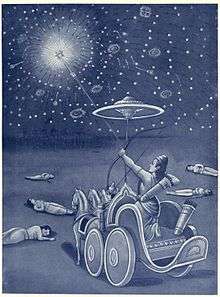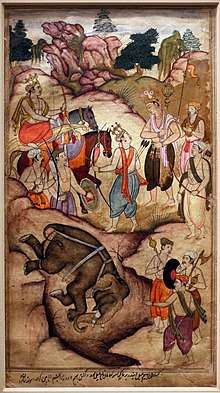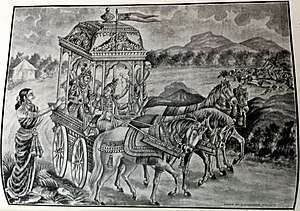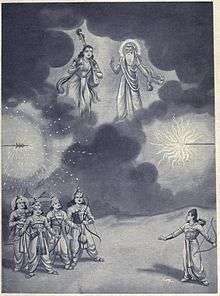Ashwatthama
Ashwathama (Sanskrit:Aśvatthāmā) or Drauni is the son of guru Drona and the grandson of the sage Bharadwaja. Ashvatthama is a Maharathi[1] who fought on the Kaurava side against the Pandavas in the Kurukshetra War. He became a Chiranjivi (immortal) due to a curse on him by Lord Krishna after he shot the Brahmashirastra over Uttara's womb. The deceptive plot of his rumoured death led to the beheading of his grieving father Drona, who was incapacitated while meditating for his son's soul. Ashvatthama was appointed as the final commander-in-chief of the Kauravas in the Kurukshetra War. Overcome with grief and rage, he slaughters most of the Pandava camp in a single night offensive. Ashwatthama ruled the Northern Panchala being subordinate to the rulers of Hastinapura. He was one of the warriors of mahabharat war who crossed all limits of conduct and even misused divine Astras.
| Ashwatthama | |
|---|---|
| Mahabharata character | |
 Ashvatthama uses Narayanastra | |
| In-universe information | |
| Weapon | Bow and Arrow,Sword |
| Family | Dronacharya (father) Kripi (mother) Kripacharya (maternal uncle) Bharadwaja (grandfather) |
Etymology
According to The Mahabharata, Ashvatthama means "the sacred voice which relates to that of a horse".[2] It is so called because when he was born he cried like a horse.[3]
Birth and Life Prior to the War
Ashwatthama is the son of Dronacharya and Kripi. Drona does many years of severe penance to please Lord Shiva in order to obtain a son who possesses the same valiance as Lord Shiva. He was a Chiranjivi. Ashvatthama is born with a gem on his forehead which gives him power over all living beings lower than humans; it protects him from hunger, thirst, and fatigue. Though an expert in warfare, Dronacharya lives the simple life, with little money or property. As a result, Ashvatthama has a difficult childhood, with his family unable to even afford milk. Wanting to provide a better life for his family, Drona goes to the Panchal Kingdom to seek aid from his former classmate and friend, Drupada. However, Drupada rebukes the friendship, claiming a king and a beggar cannot be friends, humiliating Drona.
After this incident, and seeing the plight of Drona, Kripacharya invites Drona to Hastinapur. There, he comes upon the attention of his co-disciple Bhishma. Thus, Dronacharya becomes the guru of both Pandavas and Kauravas in Hastinapur. Ashwatthama is trained in the art of warfare along with them.[4]
Role in the Kurukshetra war
Since Hastinapura, ruled by King Dhritarashtra, offered Dronacharya the privilege of teaching the Kuru princes, both Dronacharya and Ashwatthama are loyal to Hastinapur and fight for the Kauravas in the Kurukshetra war. Before Dronacharya's death, Ashwatthama visits his father, desiring a blessing of victory that he is denied. Drona advises Ashwatthama to win the war using his own strength and not through a blessing.
On the 14th day of the war, he kills a division of Rakshasas and Anjanaparvan (son of Ghatotkacha). He also stands against Arjuna several times, trying to prevent him from reaching Jayadratha, but is eventually defeated by Arjuna.
Death of Drona

On the 10th day of the war, after Bhishma falls, Drona is named the supreme commander of the armies. He promises Duryodhana that he will capture Yudhishthira, but then he repeatedly fails to do so. Duryodhana taunts and insults him, which greatly angers Ashwatthama, causing friction between Ashwatthama and Duryodhana. Krishna knows that it was not possible to defeat an armed Drona. So, Krishna suggests to Yudhishthira and the other Pandavas, if Drona were convinced that his son was killed on the battlefield, then his grief would leave him vulnerable to attack.
Krishna hatches a plan for Bhima to kill an elephant by the name Ashwatthama while claiming to Drona it was Drona's son who was dead. Ultimately, the gambit works (though the details of it vary depending on the version of the Mahabharata), and Dhristadyumna beheads the grieving sage.
Narayanastra usage
After learning of the deceptive way his father was killed, Ashwatthama becomes filled with wrath and invokes the celestial weapon called the Narayanastra, against the Pandavas.
When the weapon is invoked, violent winds begin to blow, peals of thunder are heard, and an arrow appears for every Pandava soldier. This puts fear into the Pandava army, but on Krishna instructions all the troops abandoned their chariots and also lay down all its weapons and surrender it to the weapon. As lord krishna himself being the incarnation of Narayana, he knows about the weapon, as the weapon only targets an armed person while ignores unarmed ones. After getting their soldiers to disarm (including Bhima with some difficulty), the astra passes by harmlessly. When urged by Duryodhana to use the weapon again, desirous of victory, Aswatthama sadly responds that if the weapon is used again, it will turn on its user.
According to the Chaturdhar compilation, the Narayanastra destroys one Akshauhini of Pandava army completely. After the use of Narayanastra, a terrible war between both armies takes place. Ashvatthama defeats Dhrishtadyumna in direct combat, but failed to kill him as Satyaki and Bhima cover his retreat.[5]
As the battle continues, Ashwatthama manages to kill King Nila of Mahismati.
Becoming commander
After the terrible deaths of Dushasana and Karna, Ashwatthama suggests Duryodhana to make peace with the Pandavas, keeping in mind the welfare of Hastinapur. Later, after Duryodhana is struck down by Bhima and facing death, the last three survivors from the Kaurava side, Ashwatthama, Kripa, and Kritvarma rush to his side. Ashwatthama swears to bring Duryodhana revenge, and Duryodhana appoints him as the commander-in-chief.
Attack on Pandava Camp
Along with Kripa and Kritavarma, Ashwatthama plans to attack the Pandavas camp at night.
Ashwatthama first kicks and awakens Dhrishtadyumna, the commander of the Pandava army and the killer of his father.[6] Ashwatthama strangles the half-awake Dhrishtadyumna by choking him to death as the prince begs to be allowed to die with a sword in his hand. Ashwatthama proceeds with butchering the remaining warriors, including Shikhandi, Yudhamanyu, Uttamaujas, and many other prominent warriors of the Pandava army; many texts put an emphasis on his exploits against those from Panchal. He also kills Draupadi's children in their sleep. Even as some soldiers try and fight back, Ashwatthama remains unharmed due his activated abilities as one of the eleven Rudras. Those who try to flee from Ashwatthama's wrath are hacked down by Kripacharya and Kritavarma at the camp's entrances.
After the slaughter, the three warriors go to find Duryodhana. After relaying to him the deaths of all the Panchalas, they announce that the Pandavas have no sons with whom to rejoice their victory. Duryodhana felt greatly satisfied and avenged at Ashwatthama's ability to do for him what Bhisma, Drona, and Karna could not. With this, Duryodhana breathes his last, and mourning, the three remaining members of the Kaurava army perform the cremation rites.
Aftermath of the Attack

The Pandavas and Krishna who were away during night, now return to their camp the next day morning. Hearing the news of these events Yudhishthira faints and the Pandavas become inconsolable. Bhima angrily rushes to kill Drona's son. They find him at sage Vyasa's ashram near the bank of Bhagiratha.
The now triggered Ashwatthama invokes the Brahmashira against the Pandavas to fulfill the oath of killing them. Krishna asks Arjuna to fire the Brahmashira, the anti-missile, against Ashvatthama to defend themselves. Vyasa intervene and prevent the weapons from clashing against each other. He asks both Arjuna and Ashwatthama to take their weapons back. Arjuna, knowing how to do so takes it back.

Ashwatthama not knowing how to take back the Brahmastra,instead directs the weapon towards the womb of the pregnant Uttara in an attempt to end the lineage of the Pandavas. The angered Pandavas try to kill Ashwatthama, but the Supreme lord Sri Krishna curses that he will suffer to the excessive amount but still he will not die, his skin will start to melt but still he will not die, nobody will come in front of him, everyone will hate him, but he will not die, hanker for death but he will not die.
Meanwhile, Supreme Lord Sri Krishna goes to the womb of Uttara and on the request of Draupadi and Subhadra saves her child from Brahmshirastra. As the child faced a test of life even before being born, Lord Sri Krishna names him Parikshit (Tested one)and later on succeeds Yudhisthira to become king of Hastinapur.
Lineage
A theory is propounded by historians R. Sathianathaier and D. C. Sircar, with endorsements by Hermann Kulke, Dietmar Rothermund and Burton Stein.[7] Sircar points out that the family legends of the Pallavas speak of an ancestor descending from Ashwatthama and his union with a Naga princess. It was the son born from this union, that would have started this dynasty. This claim finds support in the fact that Kanchipuram was where the Pallavas would dwell, and this was earlier a part of the Naga Kingdom. And a further corroboration is that the gotra of the Pālave Maratha family is Bharadwaja (grandfather of Ashwatthama), same as the one which Pallavas have attributed to themselves in their records.[8]
References
- K M Ganguly (1883–1896). The Mahabharata, Book 5 Udyoga Parva, Section CLXVIII sacred-texts.com, October 2003, Retrieved 2014-02-11
- http://www.sacred-texts.com/hin/m07/m07193.htm
- http://spokensanskrit.de/index.php?tinput=azvatthAma&direction=SE&script=HK&link=yes&beginning=
- K M Ganguly(1883-1896). The Mahabharata,Book 5 Udyoga Parva,Section CLXVIII sacred-texts.com,October 2003,Retrieved 2013-11-14
- K M Ganguly(1883-1896). The Mahabharatha Book 7: Drona page 478-479 Aswathama defeated Satyaki, Bhima, Drishtadyumna, October 2003, Retrieved 2015-01-13
- K M Ganguly(1883-1896). The Mahabharata Book 10: Sauptika Parva section 8 Ashvatthama killing Dhrishtadyumna, October 2003, Retrieved 2015-04-17
- Stein, Burton (2016). "Book Reviews : Kancipuram in Early South Indian History, by T. V. Mahalingam (Madras : Asia Publishing House, 1969), pp. vii-243". The Indian Economic & Social History Review. 7 (2): 317–321. doi:10.1177/001946467000700208. ISSN 0019-4646.: "...the rather well argued and plausible stand that the Palavas were indigenous to the central Tamil plain, Tondaimandalam..."
- Vaidya C.V.,History of Medieval Hindu India, pg.281
External links
| Wikimedia Commons has media related to Ashwatthama. |
Original text online (in Sanskrit)
- GRETIL etext (Muneo Tokunaga)
- Mahābhārata online
- History: Encounters with Ashvatthama

